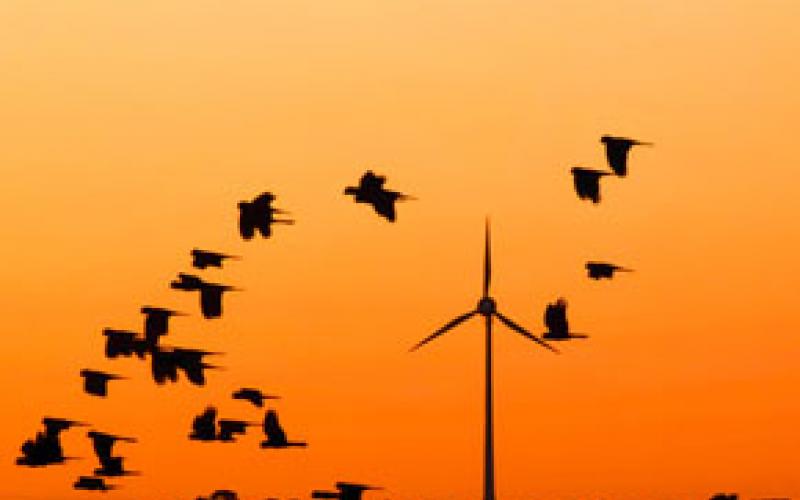Wind, oil, and gas—categorizing the ecological footprint of energy sprawl

Wind, oil, and gas—categorizing the ecological footprint of energy sprawl
Spatial analysis can be utilized as a decision-support tool to make sure energy development occurs in the least ecologically sensitive areas.
Original Paper:
Jones NF, Pejchar L. (2013) "Comparing the Ecological Impacts of Wind and Oil & Gas Development: A Landscape Scale Assessment." PLoS ONE 8(11): e81391.
DOI: http://dx.doi.org/10.10.1371/journal.pone.0081391
Landscape-scale assessments about the ecological impacts of energy production are a tool to complement field research to inform management decisions. Until today, research has mostly been confined to on-the-ground studies to analyze wildlife impacts of energy development, such as collisions of birds or bats with wind turbines. To proactively guide land-use planning, a broader assessment with geospatial software relying on indicators for biodiversity and ecosystem services in areas of energy development is instrumental. Indicators can include how wind, oil, and gas contribute to habitat loss and fragmentation, reduce carbon sequestration, and increase water usage in a region. These impacts can be assessed relatively easily and immediately using aerial imagery and geospatial data. A drawback to this approach is that the findings describe general impacts to the ecosystem and may not be applicable to understand impacts of individual species. By evaluating energy sprawl it is possible to compare the net ecological impacts of oil and gas to wind per area unit and per energy unit to calculate trade-offs and inform decision making.
Using the States of Wyoming and Colorado as study areas, researchers from Colorado State University collected information on oil and gas sites and wind farms. Through geographic information systems, they mapped three land categories: areas with oil and gas extraction, areas with wind energy development, and areas with no energy development. They applied a buffer zone of 500m around energy developments to estimate disturbance to wildlife. From their map, the researchers randomly sampled 375 plots with a 1km diameter and statistically identified indicators for biodiversity loss and reduced ecosystem quality.
The authors' findings, published in a recent article in PLOS ONE suggest that there is comparable loss of habitat and fragmentation in areas of wind development and oil and gas development. However, wind energy developers typically place turbines on previously disturbed land. This decreases the direct contributions of wind energy to habitat degradation. Wind parks, for example, are three times more likely to be placed on former croplands than oil and gas. On the other hand, wind energy requires significantly more power lines and contributes more to the building of new roads. Oil and gas energy development occurs more often in forestlands, leading to a greater negative impact on carbon storage, use of water resources, and expansion of impervious surface.
These results suggest that wind energy development contributes more to short-term ecological impacts whereas oil and gas impacts are much longer lasting. In terms of habitat loss, an American relying on wind energy would impact 247m2 per year while oil and gas energy reduces habitat by 106m2 per person annually. Over the course of 100 years, however, habitat loss from oil and gas increases significantly due to new drillings, surpassing wind energy impacts. To specify results and make develop accurate management recommendations, modifying spatial ecological models by varying the time frame and priorities for certain indicators, as well as by distinguishing between site specific and regional impacts, is decisive.
Analyzing indicators for impacts from energy development spatially and temporally can serve to proactively define optimal land use allocation. Development in previously disturbed areas such as croplands can significantly reduce additional impacts on wildlife and carbon sequestration. New drilling technologies utilizing existing well pads for new wells can reduce the land area required for oil and gas extraction. Regulators can incentivize energy development so that it occurs in previously disturbed areas or in low-carbon areas such as non-forest landscapes. Strategic siting of energy development can minimize biodiversity and ecosystem services impacts from energy sprawl.
Quantifying impacts and mitigation measures is essential to determine optimal energy production sites and provisioning. This serves to minimize the loss of natural ecosystems and enables the greatest amount of carbon storage and sequestration in a region. To inform broader economic development, an inclusive analysis also needs to consider effects of long-distance transport and processing as well as their required land use. The presented integrative framework can help address a complex challenge humanity faces—consolidating our need for energy with our desire to live in a rich and diverse natural environment.




